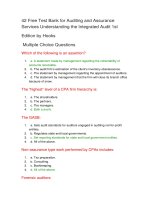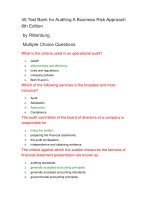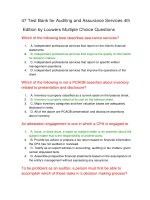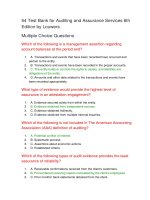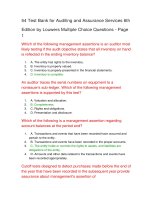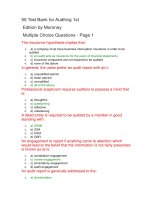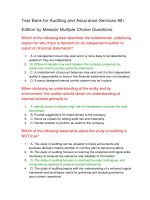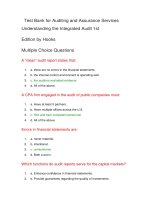99 test bank for auditing a risk based approach to conducting a quality audit 9th edition
Bạn đang xem bản rút gọn của tài liệu. Xem và tải ngay bản đầy đủ của tài liệu tại đây (151.69 KB, 27 trang )
99 Test Bank for Auditing A Risk Based Approach to
Conducting a Quality Audit 9th Edition
True False Questions - Free Text Questions - Multiple Choice
Questions
Multiple Choice Questions
Which of the following is a driver of audit quality?
1.
Audit firm culture.
2.
Engagement team skills and attributes.
3.
Factors outside control of auditors.
4.
Investor requirements.
5.
A, B, and C only.
Audit committees play an important role in promoting
independence of both internal and external auditors.
Which of the following is the most important limitation on
the effectiveness of audit committees?
1.
Audit committees may have close personal and professional friendships with
management.
2.
Audit committee members are compensated by the PCAOB.
3.
Audit committees devote their efforts to external audit concerns and do not
4.
pay much attention to internal auditing.
5.
Audit committee members are required to have degrees in non-accounting fields.
What can users can reasonably expect from the audited
financial statements?
1.
The audited financial statements are complete and contain all important financial
disclosures, are free from material misstatements, and are presented fairly.
2.
The audited financial statements are complete and contain all important financial
disclosures, are free from material misstatements, and are presented fairly according to
GAAP.
3.
The audited financial statements are complete, accurate, and are presented fairly
according to GAAP.
4.
The audited financial statements are complete, contain all important financial
disclosures, are free from all misstatements, and are presented fairly according to the
substance of GAAP.
Which of the following does the public expect of auditors?
1.
Understand and enforce principles that best portray the spirit of FASB concepts.
2.
Be neutral to preparers and users of financial information.
3.
Recognize that the investing public is the primary user of audit services.
4.
Take responsibility for the discovery of fraud.
5.
All of the above are expectations of the public.
According to the Financial Reporting Council (FRC), when is the
culture of an audit firm likely to provide a positive
contribution to audit quality?
1.
When the leadership of the audit firm ensures partners and other staff have sufficient
time and resources to deal with difficult issues as they arise.
2.
When the leadership of the audit firm ensures robust systems for client acceptance and
continuation based on ability to pay fees.
3.
When the leadership of the audit firm creates an environment where achieving
efficiency is valued, invested in and rewarded.
4.
When the leadership of the audit firm ensures financial considerations drive actions.
Which organization issued the Internal Control, Integrated
Framework which serves as the primary criterion for
evaluating the quality of a company’s internal control
system?
1.
PCAOB.
2.
COSO.
3.
AICPA.
4.
GAO.
Who licenses CPAs?
1.
The PCAOB.
2.
The AICPA.
3.
The state boards of accountancy.
4.
The SEC.
About what should an auditor assure audit committees have an
accurate understanding?
1.
Any meaningful threats to auditor objectivity.
2.
The scope of the audit.
3.
The qualitative aspects of the entity’s accounting and reporting and potential ways of
improving financial reporting.
4.
All of the above.
What should internal controls be design to do?
1.
Detect errors.
2.
Detect and prevent errors.
3.
Prevent errors.
4.
Eliminate the possibility of fraud.
Congress authorized which of the following organizations to
establish generally accepted accounting principles?
1.
SEC.
2.
APB.
3.
AICPA.
4.
FASB.
Which the following is not a reason for a public company to
receive an audit?
1.
Potential bias in providing information.
2.
Closeness between a user and the organization.
3.
Complexity of the processing systems.
4.
Remoteness between a user and the organization.
Which of the following groups is not a user of the audited
financial statements?
1.
Management.
2.
Vendors.
3.
Retired Employees.
4.
Competitors.
What must an auditor do in an audit?
1.
Consider how the economic activity is portrayed in the financial statements.
2.
Force management to make operational decisions that will improve the company’s
financial performance.
3.
Disregard independence in order to find the underlying truth of the evidence.
4.
Establish new criteria by which financial statements may be compared.
Who is responsible for internal controls within an organization?
1.
The internal auditor.
2.
The external auditor.
3.
Management.
4.
The PCAOB.
To conduct an audit, what must an auditor do?
1.
Comply with relevant ethical standards.
2.
Exercise perfect judgment.
3.
Obtain sufficient appropriate evidence to provide absolute assurance.
4.
All of the above.
According to the AICPA, which of the following is not a
safeguards to the auditing profession?
1.
Education.
2.
Professional standards.
3.
External reviews.
4.
Legislation concerning competency requirements.
An Integrated Audit Report provides opinion(s) on which of the
following?
1.
The financial statements.
2.
Internal controls.
3.
Both financial statements and internal controls.
4.
Neither financial statements or internal controls.
Which of the following is most often the client’s preferred audit
report?
1.
Qualified.
2.
Unqualified.
3.
Adverse.
4.
Disclaimer.
What can users of the audit report reasonably expect from the
audited financial statements?
1.
The financial statements are complete and contain many of the important financial
disclosures.
2.
The financial statements are presented fairly according to the substance of GAAP.
3.
The financial statements are free from all errors.
4.
All of the above.
5.
None of the above.
Which one of the following is not an example of an
independence violation?
1.
Audit partner’s spouse is the CFO at a client.
2.
Audit firm accepts money for conducting the audit.
3.
Auditors owning a small amount of stock in a client.
4.
Providing investment tips to friends about clients.
Who are the users of the financial statements?
1.
Management.
2.
Auditors.
3.
Taxing Authorities.
4.
Both A and C.
What is the first phase in an audit?
1.
Client acceptance or client continuance.
2.
Understanding the client.
3.
Understanding internal controls.
4.
Testing of account balances.
Which of the following procedures do third-party users of the
audit report not expect the auditor to perform?
1.
Evaluate measurements and disclosures made by management.
2.
Provide a biased evaluation of the financial statements.
3.
Determine whether financial statements are presented in accordance with GAAP.
4.
Gather sufficient appropriate evidence to support their opinion.
What is the role of the court system for the auditing
profession?
1.
To act as a quality-control mechanism.
2.
To provide guidance on unclear legislation.
3.
To punish audit firms that issue the wrong audit report.
4.
All of the above.
An “integrated audit” includes an audit of what?
1.
The company’s internal controls.
2.
The company’s financial statements.
3.
The company’s compliance with its rules and policies.
4.
Both A and B.
Which of the following is not part of the systematic process
called auditing?
1.
Communicating results of the audit to users.
2.
Procuring and evaluating evidence.
3.
Providing important managerial decisions for a client.
4.
Comparing evidence regarding assertions to certain established criteria.
What is the audit committee of the board of directors of a
company is responsible for?
1.
Hiring the auditor.
2.
Preparing the financial statements.
3.
The audit workpapers.
4.
Obtaining evidence.
What is the primary objective of the independent auditor’s
report on financial statements?
1.
To report on all incidence of fraud.
2.
To assist the board in evaluating management’s effectiveness.
3.
To express the auditors opinion on the internal controls.
4.
To give credibility to management’s prepared financial statements.
Which of the following is not required of auditors to satisfying
the interdependence standards?
1.
The auditor must be appointed by the SEC.
2.
The auditor must be intellectually honest.
3.
The auditor must be unbiased.
4.
The auditor must be objective.
Why is auditing important in a free market society?
1.
The public requires auditors to function as divisions of regulatory bodies.
2.
Auditors detect all errors and fraud perpetrated by company employees.
3.
It provides reliable information upon which to judge economic performance.
4.
The auditor is an amiable insurance policy for investors.
5.
All of the above are true
Which one of the following is a potential problem with
management's communication of financial information
that causes third parties to desire the independent
auditor's assessment of the financial statement
presentation?
1.
Complexity of transactions affecting the financial statements.
2.
Lack of criteria on which to base information.
3.
Remoteness of the user from the organization.
4.
Both A and C.
5.
Both A and B.
Which governing board performs quality reviews on registered
audit firms that audit public companies?
1.
PCAOB.
2.
GAO.
3.
AICPA.
4.
FASB.
Who does the public expect the auditor will recognize as the
primary users of the audited financial statements?
1.
Their clients.
2.
The Public Company Accounting Oversight Board.
3.
Members of management.
4.
Third-party users.
What document communicates the conclusions of the financial
statement audit?
1.
The financial statement.
2.
Written management assertion.
3.
The audit report.
4.
None of the above.
What is the term used to describe a systematic process of
objectively obtaining evidence regarding assertions about
economic actions and events to ascertain the degree of
correspondence between those assertions and
established criteria and communicating the results to
interested users?
1.
Internal audit.
2.
Financial audit.
3.
External audit.
4.
Integrated audit
The Center for Audit Quality is dedicated to enhancing investor
confidence in what?
1.
The financial markets.
2.
Management.
3.
Auditors.
4.
Both B and C.
5.
All of the above.
Which one of the following is not a key attribute needed to
perform an audit?
1.
Subject matter knowledge.
2.
Independence.
3.
Established criteria or standards.
4.
Accounting skills.
Why does the AICPA remain a valuable organization?
1.
Its continued involvement in the enforcement of auditing standards, particularly for
public companies.
2.
Its continued involvement in the regulation and enforcement of the audit profession.
3.
Its continued involvement in the education and administration of the CPA exam.
4.
Its continued involvement in the promulgation of accounting standards.
What is the management of a company is responsible for?
1.
Hiring the auditor.
2.
Preparing the financial statements.
3.
The audit workpapers.
4.
Ensuring auditor independence.
Which type of auditor may perform a financial statement audit?
1.
Public company auditors.
2.
Internal auditors.
3.
External auditor.
4.
A and C.
Which one of the following is not a management expectation for
independent auditors?
1.
An outside source of expertise on accounting matters.
2.
Individuals who perform tests and draw conclusions on assertions.
3.
A participant in management decision making.
4.
A provider of a written communication.
What must audit firms do to perform financial statement audits
for public companies?
1.
Register with the American Institute of Certified Public Accountants.
2.
Register with the Institute of Internal Auditors.
3.
Register with the U.S. General Accounting Office.
4.
Register with the Public Company Accounting Oversight Board.
As it relates to an audit, which of following statement about
professional skepticism is true?
1.
Professional skepticism is not taken into consideration.
2.
Professional skepticism relates only to the nature of procedures performed.
3.
Professional skepticism is an attitude.
4.
Professional skepticism is determined based upon the importance to a user of the
financial statements.
Which one of the following is not an example of a typical review
program?
1.
Interoffice reviews.
2.
Engagement quality review.
3.
Peer reviews.
4.
Self reviews.
True False Questions
The purpose of auditing is to improve the quality of the
information provided.
1.
True
2.
False
Internal auditors are considered part of the audit committee.
1.
True
2.
False
Auditing is the process of attesting to assertions about
economic actions and events.
1.
True
2.
False
The Sarbanes-Oxley Act sought to improve audit quality by
removing the auditor independence requirements.
1.
True
2.
False
Audit quality is driven, in part, by the audit firm’s culture.
1.
True
2.
False
Audited financial statements should be presented fairly
according to the substance of GAAP.
1.
True
2.
False
The American Institute of CPAs sets auditing standards for nonpublicly traded companies.
1.
True
2.
False
The SEC has authority to establish GAAP for all business
enterprises.
1.
True
2.
False
A free market can only exist if there is sharing of perfectly
reliable information.
1.
True
2.
False
An integrated audit requires the auditor to assess the
effectiveness of internal controls.
1.
True
2.
False
A bank using Milton Company's financial statements to
determine the creditworthiness of a potential loan to
Milton is a good example of the need for unbiased
reporting.
1.
True
2.
False
If the auditor has no reservations about management’s financial
statements then the auditor will issue a qualified opinion.
1.
True
2.
False
The Center for Audit Quality was started by the International
Federation of Accountants.
1.
True
2.
False
Auditors should conduct their work with an attitude of
professional skepticism.
1.
True
2.
False
Internal auditing only provides assurance about internal control
effectiveness.
1.
True
2.
False
The Center for Audit Quality has the primary authority to set
auditing standards.
1.
True
2.
False
Bondholders are one of the users of financial statements.
1.
True
2.
False
Though often relying on the FASB, the SEC has authority to
establish GAAP for publicly traded companies.
1.
True
2.
False
The PCAOB is responsible for conducting audits in the United
States.
1.
True
2.
False
Auditors of public companies need not adhere to the
requirements of statutory or regulatory organizations.
1.
True
2.
False
Internal controls are the responsibility of management.
1.
True
2.
False
Auditing is the process of verifying the accuracy of the financial
statements.
1.
True
2.
False
Being free from material errors is the same as being free from
all errors.
1.
True
2.
False
The Public Company Accounting Oversight Board was
established by the AICPA in response to Securities laws.
1.
True
2.
False
CPA certificates for auditors are issued by state boards of
accountancy.
1.
True
2.
False
The FASB provide the criteria against which the auditor can
measure the fairness of financial statement presentation.
1.
True
2.
False
External auditors frequently serve on the audit committees of
their clients.
1.
True
2.
False
The SEC provides annual reports to the PCAOB.
1.
True
2.
False
In an audit, management is considered the “client”.
1.
True
2.
False
The SEC is the governmental body with the oversight
responsibility for the efficient operation of capital markets
in the United States.
1.
True
2.
False
Users rely on the auditors' independent assessment of financial
statement presentation because few users have direct
knowledge of the company's operations.
1.
True
2.
False
The need for assurance services arises because the interests of
the users of information may be different from that of the
interests of those responsible for providing information.
1.
True
2.
False
Auditing exists because users need unbiased information on
which to assess management performance and make
economic decisions.
1.
True
2.
False
Audited financial statements should be free from all errors and
fraud.
1.
True
2.
False
The Public Company Accounting Oversight Board provides the
criteria against which the auditor measures the fairness of
financial statement presentation.
1.
True
2.
False
An auditor must have a good understanding of the risks
associated with a client's industry in order to ensure that
the financial statements reflect the underlying substance
of accounting transactions and the economic effects of
such transactions.
1.
True
2.
False
The PCAOB is a public board, appointed by Congress, to
provide oversight of the firms that audit public companies
registered with the SEC.
1.
True
2.
False
Audit staff performing audit work must be appropriately
supervised by partners and managers.
1.
True
2.
False
The external auditors are only responsible for their opinion of
the financial statements and internal controls.
1.
True
2.
False
The internal audit profession adheres exclusively to standards
set by the Public Company Accounting Oversight Board.
1.
True
2.
False
A financial statement audit is a systematic process of
objectively obtaining and evaluating evidence.
1.
True
2.
False
Only the Big 4 audit firms can conduct audits of private
companies in the United States.
1.
True
2.
False
In all states, a CPA must have completed at least 150 hours of
college semester hours to receive their license.
1.
True
2.
False
A quality audit is one performed “in accordance with generally
accepted auditing standards (GAAS) to provide
reasonable assurance that the audited financial
statements and related disclosures are presented in
accordance with generally accepted accounting principles
(GAAP) and (2) are not materially misstated whether due
to errors or fraud.”
1.
True
2.
False
Auditors need only understand the rules of accounting as the
principles of accounting are outdated.
1.
True
2.
False
Free Text Questions
Attributes of Auditors: Discuss the three or more attributes that
an auditors possess in order to maintain credibility.
Explain the importance of these attributes to the audit.
Answer Given
1) Subject Matter Knowledge - The assurance provider must be an expert in the area
of service provided. Expertise in a complex body of knowledge sets the assurance
professional apart from others.; 2) Independence - The assurance provider must be
unbiased, free from conflict of interest, objective and independent of the company
receiving assurance services. This allows the professional to remain neutral and free
from influence by parties with a vested interest in the outcome of assurance services.;
3) Agreed Upon Criteria - Clear criteria must be available for the assurance provider to
measure objectives and results against. In a financial statement assurance
engagement, the criteria are represented by Generally Accepted Accounting
Principles.; 4) Process Expertise - Evidence is obtained and evaluated during the
course of an assurance engagement. Professionals providing these services must be
able to draw accurate conclusions based upon the results of testing competent,
sufficient evidence obtained.
Requirements of auditors in public accounting: Recent
landscape changes in accounting and auditing developed
from corporate fraud and, arguably, auditor failure. In
order to continually lead and adapt to the dynamics of
regulation, principles based accounting practices and
auditing standards, what types of skills and traits are
auditors required to possess?
Answer Given
In addition to integrity, ethics and independence, auditors must possess an inherent
ability to understand the client. This pertains not only to the manner in which the
company operates, but the industry in which the client participates. The auditor must
be able to use sound professional judgment and skepticism to perceive issues and
propose solutions. An auditor must understand the environment in which a client does
business. The surrounding economic, cultural and political aspects of a company are
all vital to the auditor's understanding of risks. An auditor must be able to interpret a
complex body of knowledge, apply audit procedures and measure assertions against
the criteria of generally accepted accounting principles. Risks must be adequately
considered for the audit and the client so that the audit firm may reduce exposure in
the marketplace. Information technology used by clients must also be understood by
the auditor so that internal control, prevention and detection of misstatements and the
audit trail might be assessed. Similarly, the auditor must use software to perform an
audit efficiently and adequately.
The Need for Audited Financial Statements: Why do financial
statement users need independent assurance about
information provided by management?
Answer Given
The need for independent assurance arises from several factors: * Potential bias —
Management has incentives to bias financial information in order to convey a better
impression of the financial data than real circumstances might merit. For example,
management’s compensation may be tied to profitability or stock price, so managers
may be tempted to “bend” GAAP to make the organization’s performance look better.;
* Remoteness —An organization and the users of its financial information are often
remote from each other, both in terms of geographic distance and the extent of
information available to the both parties. Most users cannot interview management,
tour a company’s plant, or review its financial records firsthand; instead, they must rely
on financial statements to communicate the results of management’s performance.
This can tempt management to keep information from users or bend GAAP so the
organization looks better.; *Complexity —Transactions, information, and processing
systems are often very complex, so it can be difficult to determine their proper
presentation. This provides an opportunity for management to deceive users.; *
Consequences —During the past decade, many financial statement users —pension
funds, private investors,venture capitalists, and banks —lost billions of dollars because
financial information had become unreliable. As an example, the factors leading up to,
and the consequences of, unreliable information can be seen in the sub-prime
mortgage crisis in the United States. Many borrowers did not provide correct
information on their loan applications and lenders sometimes did not perform adequate
due diligence in making lending decisions. Consequently,various financial statement
users and others suffered significant losses. When financial information is not
reliable,investors and other users lose a significant source of information that they
need to make decisions that have important consequences.
Audit Quality: What is audit quality?
Answer Given
A definition published by the GAO (2003) states that a quality audit is one performed
“in accordance with generally accepted auditing standards (GAAS) to provide
reasonable assurance that the audited financial statements and related disclosures
are presented in accordance with generally accepted accounting principles GAAP and
(2) are not materially misstated whether due to errors or fraud. ”
Impact of Sarbanes-Oxley: What are four ways that SarbanesOxley impacted the auditing profession?
Answer Given
• Increased auditor independence; • Enhanced the role and importance of the audit
committee; • Required reporting on internal control over financial reporting; • Provided
oversight of the external auditing profession by the Public Company Accounting
Oversight Board (PCAOB)
Professional and regulatory organizations: Identify at least four
professional or regulatory organizations. Explain how and
why they assist and/or monitor the audit and assurance
profession.
Answer Given
PCAOB is the primary governing regulatory body of auditors of public company
financial statements. It was established by the Congress as a result of the SarbanesOxley Act of 2002. It sets auditing standards for audits of public companies, requires
registration of audit firms auditing public companies and performs quality reviews of
registered firms. AICPAWith the establishment of the PCAOB, the role of the AICPA
has diminished. Membership in the organization is voluntary. The AICPA establishes
standards for other attestation services, accounting and review services, consulting
and tax services. It organizes continuing education programs and administers the
Uniform CPA Examination. State Boards of Accountancy license CPAs and are
charged with regulating the profession at the state level. SEChas been granted
authority to establish GAAP for publicly traded companies. Its primary mission is to
protect the investing public; it has oversight of the PCAOB. The GAOis responsible for
setting forth auditing standards for governmental agencies. The IIAis a voluntary
organization that administers the Certified Internal Auditor program and issues
standards for the practice of internal audit.
Users of financial statements: Identify at least three types of
users of financial statements. Describe their primary use
of the financial statements and how the misstatement of
those statements might injure the user.
Answer Given
Users of audited financial statements may include: • Management may utilize the audit
report to determine whether the financial statements are presented in accordance with
GAAP, whether the firm is availing itself of appropriate internal controls, and as a
means of evaluating employee performance. Misstatement of the financial statements
would cause the client to make erroneous decisions about financial position, internal
controls and employee rewards and punishments.; • A financial institution that is asked
to make a loan uses the financial statement to judge the credit worthiness of the
borrower. Misstatements in the financial statements lead to errors in lending that
jeopardize the assets of the bank and depositors.; • A vendor who is asked to grant
credit uses the statements and faces injury in a manner similar to the financial
institution.; • A third-party stockholder uses the financial statements to determine if the
investment will provide the returns consistent with the needs of the investor.
Misstatements of the financial statements will lead to different results or possible loss
of the investment.; • Others: Potential stockholders, taxing authorities, regulatory
agencies, labor unions, employees, bondholders, court system, retirement plans, or
retired employees
Overview of Financial Statement Audit: Define auditing and
discuss how its components fit into an overview of a
financial statement audit.
Answer Given
Financial statement auditing has been defined as a “systematic process of actively
obtaining and evaluating evidence regarding assertions about economic actions and
events to ascertain the degree of correspondence between those assertions and
established criteria and communicating the results to interested users.”
Audit Quality: What are three drivers of audit quality according
to the Financial Reporting Council (FRC)’s “The Audit
Quality Framework”?
Answer Given
There are five primary drivers of audit quality, including (1) audit firm culture, (2) the
skills and personal qualities of audit partners and staff, (3) the effectiveness of the
audit process, (4) the reliability and usefulness of audit reporting, and (5) factors
outside the control of auditors that affect audit quality.
Regulatory and professional bodies: Write the full name of the
following regulatory and professional acronyms and
describe the function of each entity: PCAOB; AICPA; SEC;
IIA; FASB
Answer Given
PCAOB is the primary governing regulatory body of auditors of public company
financial statements. It was established by the Congress as a result of the SarbanesOxley Act of 2002. It sets auditing standards for audits of public companies, requires
registration of audit firms auditing public companies and performs quality reviews of
registered firms. The PCAOB is overseen by the SEC. AICPAWith the establishment of
the PCAOB, the role of the AICPA has diminished. Membership in the organization is
voluntary. The AICPA establishes standards for other attestation services, accounting
and review services, consulting and tax services. It organizes continuing education
programs and administers the Uniform CPA Examination. Securities and Exchange
CommissionCongress established the SEC to regulate the capital market system and
establish GAAP for publicly traded companies. The SEC delegated the standard
setting authority to the FASB but reviews and suggests standards when necessary.
The SEC oversees the responsibilities of the PCAOB. Institute of Internal AuditorsThe
IIA issues standards and interpretations of standards for internal auditing. It also
administers the Uniform CIA Examination and the certified internal auditor program to
establish the benchmark measure of competence for the internal auditing profession.
Financial Accounting Standards BoardThe FASB is charged with issuing authoritative
accounting pronouncements.
